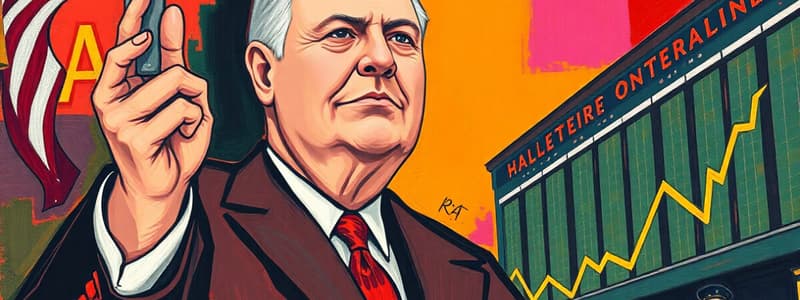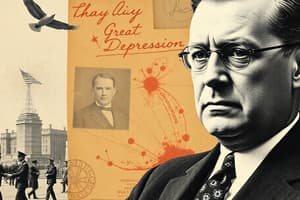Podcast
Questions and Answers
What was a significant factor that led to the panic on Wall Street during the crash of 1929?
What was a significant factor that led to the panic on Wall Street during the crash of 1929?
- A sudden increase in stock prices
- A failure of the stock ticker to record price fluctuations (correct)
- The introduction of new banking regulations
- An economic boom in other countries
Which event is referred to as 'Black Monday'?
Which event is referred to as 'Black Monday'?
- The day banks began failing
- The day investors started to buy stocks again
- October 28th, when the DJIA lost 12.82% (correct)
- The day the stock market crashed for the first time
What measures did Richard Whitney implement during the 1929 stock market crash?
What measures did Richard Whitney implement during the 1929 stock market crash?
- He enforced stricter trading regulations
- He made large purchases using funds from leading bankers (correct)
- He encouraged investors to sell all their stocks immediately
- He called for a nationwide strike of stockbrokers
How did the Wall Street crash of 1929 contribute to the onset of the Great Depression?
How did the Wall Street crash of 1929 contribute to the onset of the Great Depression?
What is emphasized as an important lesson from the experience of the Great Depression?
What is emphasized as an important lesson from the experience of the Great Depression?
What was a key aspect of Hoover's campaign message?
What was a key aspect of Hoover's campaign message?
What significant milestone did the Dow Jones Industrial Average reach in March 1929?
What significant milestone did the Dow Jones Industrial Average reach in March 1929?
What practice allowed investors to buy stocks by borrowing funds?
What practice allowed investors to buy stocks by borrowing funds?
What contributed to the increased number of bad loans in the late 1920s?
What contributed to the increased number of bad loans in the late 1920s?
How did farmers react during the economic boom of the 1920s?
How did farmers react during the economic boom of the 1920s?
What event is commonly referred to as 'Black Thursday'?
What event is commonly referred to as 'Black Thursday'?
What action did the Federal Reserve Bank of New York take in 1929?
What action did the Federal Reserve Bank of New York take in 1929?
What was one consequence of the economic boom in the 1920s?
What was one consequence of the economic boom in the 1920s?
Flashcards are hidden until you start studying
Study Notes
Herbert Hoover's Inauguration
- Herbert Hoover was inaugurated as the 31st president of the United States on March 4th, 1929 in Washington D.C.
- In his inaugural address, Hoover spoke of the "higher degree of comfort and security" and "individual freedom" that the US had achieved.
- Hoover's campaign had focused on prosperity, with a local campaign flier stating that Republican policies had brought "a chicken in every pot, and a car in the backyard."
The Stock Market Boom
- The Dow Jones Industrial Average (DJIA) reached an all-time high of 381 in the month of Hoover's inauguration.
- The stock market had climbed for nine years, increasing six-fold from its 1921 levels.
- The relentless upward trend led many to believe investments were a sure thing, resulting in a surge of investors, including factory workers, restaurant owners, and even shoeshine boys.
- Easy loans and installment buying fueled the economic boom of the 1920s, with businesses taking out loans to expand and families purchasing new goods and home improvements.
- Henry Ford's installment plan for the Model T led to a massive boom in auto sales, boosting related industries such as steel, glass, petroleum, and rubber.
- Farmers borrowed money to mechanize and expand their acreage, leading to overproduction and difficulty making money.
The Margin Call Crisis
- Stockbrokers offered loans for investors to buy stock, a practice called "buying on the margin."
- Investors, including those mortgaging their homes and businesses, were putting down only 10% of a stock's worth, borrowing the rest.
- If the value of a stock dropped, the investor's down payment would shrink, leading brokers to request more money from investors.
- Failure to provide the necessary funds resulted in the investor having to sell the stock to cover the loan.
The Rise of Bad Loans
- Easy loans and installment buying, coupled with farmer's borrowing, contributed to a large number of bad loans in the American economy.
- The Federal Reserve Bank of New York raised lending rates in 1929 to discourage borrowing, impacting European central banks and pushing many of those nations into recession.
Black Thursday: The Beginning of the Crash
- A well-respected market analyst's warning about an overvalued market, combined with European economic uncertainty, triggered market shocks in October 1929.
- On October 24th, 1929, "Black Thursday," the market lost 11% of its value within minutes of the opening bell.
- Panic spread throughout Wall Street as the stock ticker failed to record the rapid fluctuations in prices.
- Rumors of stockbrokers committing suicide spread, fueled by the accidental death of a German chemist.
The Banking Consortium's Efforts
- Leading bankers, fearing a repeat of the Panic of 1907, gathered a pot of money to invest in the stock market and banks.
- Richard Whitney, vice-president of the New York Stock Exchange, used this money to make large purchases of major companies, temporarily halting the market decline.
Black Monday and Black Tuesday
- October 28th, "Black Monday," saw further panic as investors rushed to sell their stock, leading to a 12.82% loss in the DJIA.
- Margin calls intensified, forcing people to sell stocks to repay their loans.
- The market continued to plummet on October 29th, "Black Tuesday," with the DJIA losing 23% in two days.
- The crash intensified, with no buyers for the frantic sellers, prompting a steady descent of the DJIA that lasted until mid 1932.
The Depression and Its Impact
- The Wall Street crash of 1929 did not immediately lead to the Great Depression, which emerged months later as banks failed due to bad loans and unemployment rose.
- The crash significantly impacted consumer confidence and wiped out small investors' savings, leading to a decline in purchases of goods and services.
- The crash marked the start of a decade of disasters, including economic hardship, unemployment, and ecological devastation.
The Importance of Resilience
- The text emphasizes the importance of remembering that despite the hardship of the Great Depression, the US ultimately recovered.
- The recovery was achieved through cooperation and perseverance, highlighting the importance of resilience even during challenging times.
Herbert Hoover's Inauguration
- Herbert Hoover was sworn in as the 31st President of the United States on March 4th, 1929 in Washington D.C.
- Hoover's campaign focused on the prosperity the country had achieved thanks to Republican policies.
- His inaugural address focused on the "higher degree of comfort and security" and "individual freedom" the country had attained.
The Stock Market Boom
- The Dow Jones Industrial Average (DJIA) reached an all-time high of 381 in March 1929, the month of Hoover's inauguration.
- The stock market had risen for nine years, increasing six-fold compared to its 1921 levels.
- The relentless upward trend led many to believe investments were guaranteed, driving a surge of investors, encompassing factory workers, restaurant owners, and even shoeshine boys.
- The 1920s economic boom was fueled by easy loans and installment buying, allowing businesses to expand with loans and families to purchase new goods and home improvements.
- Henry Ford's installment plan for the Model T sparked a massive boom in auto sales, boosting related industries such as steel, glass, petroleum, and rubber.
- Farmers borrowed heavily to mechanize and expand their acreage, leading to overproduction and financial difficulties.
The Margin Call Crisis
- Stockbrokers offered loans to investors for stock purchases, a practice known as "buying on the margin."
- Investors, including those mortgaging businesses and homes, paid only 10% of a stock's value, borrowing the rest.
- If a stock's value decreased, the investor's down payment would shrink, prompting brokers to request more money from investors.
- Failure to provide the necessary funds resulted in the investor being forced to sell the stock to cover the loan.
The Rise of Bad Loans
- Easy loans and installment buying, combined with farmer's borrowing, contributed to a significant number of bad loans in the American economy.
- The Federal Reserve Bank of New York raised lending rates in 1929 to discourage borrowing, affecting European central banks and pushing many of those nations into recession.
Black Thursday: The Beginning of the Crash
- A warning from a well-respected market analyst about an overvalued market, combined with European economic uncertainty, triggered market shocks in October 1929.
- On October 24th, 1929, "Black Thursday," the market lost 11% of its value within minutes of the opening bell.
- Panic gripped Wall Street as the stock ticker failed to record the rapid price fluctuations.
- Rumors of stockbrokers committing suicide spread, fueled by the accidental death of a German chemist.
The Banking Consortium's Efforts
- Leading bankers, fearing a repeat of the Panic of 1907, pooled money to invest in the stock market and banks.
- Richard Whitney, vice-president of the New York Stock Exchange, used this money to make large purchases of major companies, temporarily halting the market decline.
Black Monday and Black Tuesday
- October 28th, "Black Monday," saw further panic as investors rushed to sell their stock, leading to a 12.82% loss in the DJIA.
- Margin calls intensified, forcing people to sell stocks to repay their loans.
- The market continued to plummet on October 29th, "Black Tuesday," with the DJIA losing 23% in two days.
- The crash escalated, with no buyers for the frantic sellers, prompting a steady descent of the DJIA that lasted until mid 1932.
The Depression and Its Impact
- The Wall Street crash of 1929 did not immediately lead to the Great Depression, which emerged months later as banks failed due to bad loans and unemployment rose.
- The crash significantly impacted consumer confidence and wiped out small investors' savings, leading to a decline in purchases of goods and services.
- The crash marked the start of a decade of disasters, including economic hardship, unemployment, and ecological devastation.
The Importance of Resilience
- The text emphasizes the importance of remembering that despite the hardship of the Great Depression, the US ultimately recovered.
- The recovery was achieved through cooperation and perseverance, highlighting the importance of resilience even during challenging times.
Studying That Suits You
Use AI to generate personalized quizzes and flashcards to suit your learning preferences.




